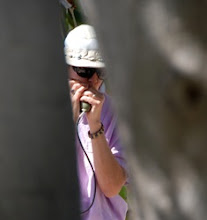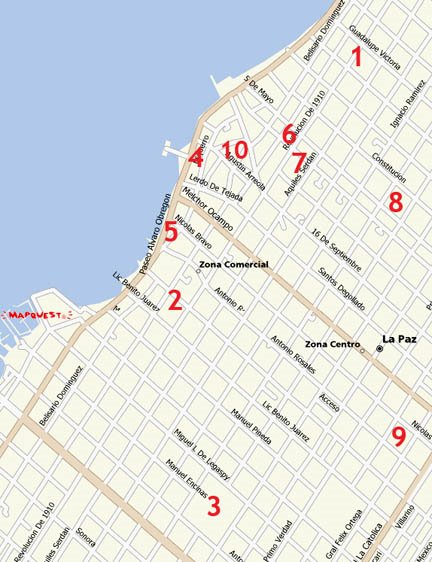Walk into the La Paz home of Genoveva Pérez León and you enter a kaleidoscope: hot-pink ribbons, a rainbow of cloth swatches piled high, shelf after shelf of jars filled with beads and shells and sequins. And everywhere there are dolls — brilliantly costumed cloth dolls.
Genoveva is a maker of muñecas. It is an art learned from her grandmother and mother on the family ranch near Todos Santos during a hurricane season 60 years ago.
"I was the oldest of 10 children. I didn't have time to make dolls because I would be doing the chores," she tells me. But when the storms hit, everyone had to hunker down indoors. While the children waited for a break in the weather, they started making dolls to pass the time. "We called them chubasqueras (storm dolls)."
Genoveva lifts one doll after another from a large glassed-in cabinet and stands them on the table. She introduces each: This one with the braids is La Serena, from the ranch land of her own Sudcaliforniana hills. This one in the ruffled orange dress is La Costa, from the coast. And this beauty in elegant red satin, sequins and embroidered flowers is Florida Pitahaya.
Genoveva is 67. I am 60. But we could be girls again, playing with dolls.
I pick up La Serena and stroke the ranchera doll's thick yarn braids, tied with pink bows. Her lips are embroidered cherry-red. I lift the ruffled flower skirt and admire the white lace petticoat, knickers and black velvety slippers.
It takes Genoveva three days to make one doll. In her work, nothing goes to waste. "I do not like to throw out cloth," she says. From small scraps, she makes dolls the size of a baby finger, each snug inside a bottle capped with a seashell.
Later, Genoveva takes me to meet her mother, Eulalia León Talamantes. Eulalia, who lives with another daughter a short drive away, has just celebrated her 91st birthday. She has lost sight in one eye, but has no problem threading a needle. And she is still making dolls.
 Yes, Eulalia says, it is a little sad to say Adios to a doll when it comes time to sell it. "But then, I can make another. I love making dolls." Her daughters estimate that their mother has made more than a thousand of them.
Yes, Eulalia says, it is a little sad to say Adios to a doll when it comes time to sell it. "But then, I can make another. I love making dolls." Her daughters estimate that their mother has made more than a thousand of them.
Eulalia is matriarch of five generations living nearby: there are 10 children, 41 grandchildren, 58 great grandchildren and 10 great-great grandchildren. The family hopes that someone among the youngsters will continue the tradition of making dolls.
But Genoveva isn't taking any chances. As part of a government project a few years ago, she taught a course in doll-making to eight women in the ranch country where she grew up. She says five of the women are continuing the work.
I ask Genoveva if there is anything else she would like to say. "Tell people, if anyone wants to learn, I would be happy to teach them, so that this art isn't lost. I love making dolls."
Where to purchase the storm dolls: You can order by phone at 612-122-6349 or look for the dolls on sale Saturdays near the kiosko on the Malecón (at the foot of 16 de Septiembre). You can also find the dolls at Allende Books, Independencia 518, between Serdan and Prieto.
Genoveva is a maker of muñecas. It is an art learned from her grandmother and mother on the family ranch near Todos Santos during a hurricane season 60 years ago.
"I was the oldest of 10 children. I didn't have time to make dolls because I would be doing the chores," she tells me. But when the storms hit, everyone had to hunker down indoors. While the children waited for a break in the weather, they started making dolls to pass the time. "We called them chubasqueras (storm dolls)."
Genoveva lifts one doll after another from a large glassed-in cabinet and stands them on the table. She introduces each: This one with the braids is La Serena, from the ranch land of her own Sudcaliforniana hills. This one in the ruffled orange dress is La Costa, from the coast. And this beauty in elegant red satin, sequins and embroidered flowers is Florida Pitahaya.
Genoveva is 67. I am 60. But we could be girls again, playing with dolls.
I pick up La Serena and stroke the ranchera doll's thick yarn braids, tied with pink bows. Her lips are embroidered cherry-red. I lift the ruffled flower skirt and admire the white lace petticoat, knickers and black velvety slippers.
It takes Genoveva three days to make one doll. In her work, nothing goes to waste. "I do not like to throw out cloth," she says. From small scraps, she makes dolls the size of a baby finger, each snug inside a bottle capped with a seashell.
Later, Genoveva takes me to meet her mother, Eulalia León Talamantes. Eulalia, who lives with another daughter a short drive away, has just celebrated her 91st birthday. She has lost sight in one eye, but has no problem threading a needle. And she is still making dolls.
 Yes, Eulalia says, it is a little sad to say Adios to a doll when it comes time to sell it. "But then, I can make another. I love making dolls." Her daughters estimate that their mother has made more than a thousand of them.
Yes, Eulalia says, it is a little sad to say Adios to a doll when it comes time to sell it. "But then, I can make another. I love making dolls." Her daughters estimate that their mother has made more than a thousand of them.Eulalia is matriarch of five generations living nearby: there are 10 children, 41 grandchildren, 58 great grandchildren and 10 great-great grandchildren. The family hopes that someone among the youngsters will continue the tradition of making dolls.
But Genoveva isn't taking any chances. As part of a government project a few years ago, she taught a course in doll-making to eight women in the ranch country where she grew up. She says five of the women are continuing the work.
I ask Genoveva if there is anything else she would like to say. "Tell people, if anyone wants to learn, I would be happy to teach them, so that this art isn't lost. I love making dolls."
Where to purchase the storm dolls: You can order by phone at 612-122-6349 or look for the dolls on sale Saturdays near the kiosko on the Malecón (at the foot of 16 de Septiembre). You can also find the dolls at Allende Books, Independencia 518, between Serdan and Prieto.



